
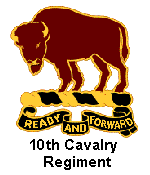
10th Cavalry Regiment
Organizational Legacy
"Ready And Forward"



Regimental Distinctive Unit Insignia
 Introduction
Introduction


 The 1st Cavalry Division, a major subordinate command of the US Third Mobile
Armored Corps, is a 19,000 soldier, heavy armored division stationed at Ft.
Hood, TX. As one of the two "on-call" heavy contingency force divisions of the
Army, the First Team has an on-order mission to deploy by sea, air or land to
any part of the world on a short notice. The following narratives, divided in
timeline eras of major operational missions, describes the threat environment,
tactical conditions, evolution of equipment technology and the strategic
methodology employed by one of its subordinate units, the 10th Cavalry
Regiment, to contribute to the successful missions and enhancement of the
warring organization of the 1st Cavalry Division.
The 1st Cavalry Division, a major subordinate command of the US Third Mobile
Armored Corps, is a 19,000 soldier, heavy armored division stationed at Ft.
Hood, TX. As one of the two "on-call" heavy contingency force divisions of the
Army, the First Team has an on-order mission to deploy by sea, air or land to
any part of the world on a short notice. The following narratives, divided in
timeline eras of major operational missions, describes the threat environment,
tactical conditions, evolution of equipment technology and the strategic
methodology employed by one of its subordinate units, the 10th Cavalry
Regiment, to contribute to the successful missions and enhancement of the
warring organization of the 1st Cavalry Division.
Mission:
 The mission of the 10th Cavalry Regiment is to deploy to a designated
contingency area of operations and conduct full spectrum operations in support
ith mission of its cognizant Brigade On order, redeploys and prepares for
future operations.
The mission of the 10th Cavalry Regiment is to deploy to a designated
contingency area of operations and conduct full spectrum operations in support
ith mission of its cognizant Brigade On order, redeploys and prepares for
future operations.
Organizational Summary:
|
|
|---|
| 9th and 10th Cavalry Histories |
|---|
|
|
|---|
 This video clip summarizes the background of the organization and history
of the 9th and 10th Cavalry Regiments. At the end of the Civil War, the ranks
of the Regular cavalry regiments were thin indeed, as were those of the other
Regular regiments. Of the 448 companies of cavalry, infantry, and artillery
authorized, 153 were not organized, and few, if any, of those in being were
at full strength. By the early summer of1866, this shortage had eased since
many of the members of the disbanded Volunteer outfits had by then enlisted as
Regulars. By that time, however, it became apparent in Washington that the
Army, even at full strength, was not large enough to perform its duties.
This video clip summarizes the background of the organization and history
of the 9th and 10th Cavalry Regiments. At the end of the Civil War, the ranks
of the Regular cavalry regiments were thin indeed, as were those of the other
Regular regiments. Of the 448 companies of cavalry, infantry, and artillery
authorized, 153 were not organized, and few, if any, of those in being were
at full strength. By the early summer of1866, this shortage had eased since
many of the members of the disbanded Volunteer outfits had by then enlisted as
Regulars. By that time, however, it became apparent in Washington that the
Army, even at full strength, was not large enough to perform its duties.
 When Congress reorganized the peacetime regular army on 28 July, 1866, it had
taken the above situation into account. It also recognized the military merits
of black soldiers by authorizing two segregated regiments of black cavalry,
the Ninth United States Cavalry and the Tenth United States Cavalry and the
24th, 25th , 38th , 39th, 40th and 41st Infantry Regiments. Orders were given
to transfer the troops to the western war arena, where they would join the
army's fight with the Indians.
When Congress reorganized the peacetime regular army on 28 July, 1866, it had
taken the above situation into account. It also recognized the military merits
of black soldiers by authorizing two segregated regiments of black cavalry,
the Ninth United States Cavalry and the Tenth United States Cavalry and the
24th, 25th , 38th , 39th, 40th and 41st Infantry Regiments. Orders were given
to transfer the troops to the western war arena, where they would join the
army's fight with the Indians.
 Cavalry companies accounted for 20 percent of the total number of company
sized organizations. The Regular Army's authorized strength of approximately
57,000 officers and men was then more than double what it had been at the
close of the war. The whole arrangement was remarkable because it was the
first time in the nation's history that the Regular establishment had been
increased substantially immediately after a war. Recruiting, to obtain the
increase in man power force levels, began at once. Emphasis was placed upon
securing veteran Volunteers before they left the service. The officers were
selected from both Volunteers and Regulars; each candidate was required to
have had at last two years of honorable service in the Civil War.
Cavalry companies accounted for 20 percent of the total number of company
sized organizations. The Regular Army's authorized strength of approximately
57,000 officers and men was then more than double what it had been at the
close of the war. The whole arrangement was remarkable because it was the
first time in the nation's history that the Regular establishment had been
increased substantially immediately after a war. Recruiting, to obtain the
increase in man power force levels, began at once. Emphasis was placed upon
securing veteran Volunteers before they left the service. The officers were
selected from both Volunteers and Regulars; each candidate was required to
have had at last two years of honorable service in the Civil War.
 The new cavalry regiments, numbered 9th, and 10th, were organized under the
same tables as the 6 already in existence. A regiment consisted of 12
companies formed into 3 squadrons of 4 companies each. Besides the commanding
officer who was a colonel, the regimental staff included 7 officers, 6
enlisted men, a surgeon, and 2 assistant surgeons. Each company was authorized
4 officers, 15 noncommissioned officers, and 72 privates. A civilian
veterinarian accompanied the regiment although he was not included in the
table of organization.
The new cavalry regiments, numbered 9th, and 10th, were organized under the
same tables as the 6 already in existence. A regiment consisted of 12
companies formed into 3 squadrons of 4 companies each. Besides the commanding
officer who was a colonel, the regimental staff included 7 officers, 6
enlisted men, a surgeon, and 2 assistant surgeons. Each company was authorized
4 officers, 15 noncommissioned officers, and 72 privates. A civilian
veterinarian accompanied the regiment although he was not included in the
table of organization.
 On 23 November 1866, Army General Orders No. 92, expressly of effect from 21
September, announced the numerical designation, the field officers (so far as
they have accepted) and the stations or headquarters of the new regiments of
cavalry, also of certain new regiments of infantry forming under the same
act.
On 23 November 1866, Army General Orders No. 92, expressly of effect from 21
September, announced the numerical designation, the field officers (so far as
they have accepted) and the stations or headquarters of the new regiments of
cavalry, also of certain new regiments of infantry forming under the same
act.
 On 09 August, 1866, with Congress having created the 10th Cavalry in law, the
first step towards its creation in fact was taken, by Lieutenant-General
Sherman, commanding the Military Division of the Mississippi, in a General
Order No. 6, from his headquarters at St. Louis, Missouri. The order read as
follows:
On 09 August, 1866, with Congress having created the 10th Cavalry in law, the
first step towards its creation in fact was taken, by Lieutenant-General
Sherman, commanding the Military Division of the Mississippi, in a General
Order No. 6, from his headquarters at St. Louis, Missouri. The order read as
follows:
- I. Commanders of military departments within this division in
which colored troops are serving, will proceed at once to
enlist men for two regiments of colored regulars, under the Act
of Congress approved 28 July, 1866, entitled "An Act to
increase and fix the military peace establishment of the United
States;" one of cavalry, to be entitled the 10th Regiment
United States Cavalry, and one of infantry to be entitled the
38th Regiment United States Infantry.
- II. Fort Leavenworth, Kansas, is hereby named as the headquarters
and rendezvous of the 10th Cavalry, and Jefferson Barracks,
Missouri, the headquarters and rendezvous of the 38th
Infantry.
- III. Commanding-generals of the Departments of the Missouri,
Arkansas, and Platte, will detail one or more officers of the
Regular Army, who will proceed to canvass the regiments of
colored troops now serving in their respective departments,
and enlist men for the new regiments above named, the cavalry
for five years and the infantry for three years. The men so
enlisted will be discharged from their present obligation and
grouped into companies under officers to be selected by the
colonels or regimental commanders hereafter to be appointed,
but will be retained for the present at or near their present
station. The number of privates allowed to a company is
sixty-four. The men of existing colored regiments not willing
to enlist in the new organizations will, for the present, be
consolidated into companies under the direction of their
immediate commanders, and held to service until the new army
is sufficiently organized to replace them.
- IV. The field officers of these regiments will, on arrival at
these headquarters, proceed to the posts herein named and
organize their new regiments according to law and regulations,
but will not withdraw the new companies from their present
stations without consent of department commanders, or orders
from these headquarters.
- V. Blanks will at once be sent from these headquarters, to which
all reports will be made until the regular field officers are
announced and recruitment organized under them. By order, etc.
 The first regimental report was rendered on the 30 September, 1866. It showed
the aggregate strength of the regiment, present and absent, to consist of two
officers, Colonel Benjamin H. Grierson, and Lieutenant-Colonel Charles C.
Walcutt, and gave the number of recruits required as 1092. Colonel Grierson
was reported present with the regiment, and Colonel Walcutt absent on
regimental recruiting service.
The first regimental report was rendered on the 30 September, 1866. It showed
the aggregate strength of the regiment, present and absent, to consist of two
officers, Colonel Benjamin H. Grierson, and Lieutenant-Colonel Charles C.
Walcutt, and gave the number of recruits required as 1092. Colonel Grierson
was reported present with the regiment, and Colonel Walcutt absent on
regimental recruiting service.
 The first commander of the 10th Cavalry is doubtless known personally as well
as by reputation to most of the readers of this sketch. His raid through
Mississippi in 1863 is the historic operation on which his reputation chiefly
rests. It has placed him among the foremost cavalry leaders of the War, and
seems destined, as it becomes better known and more justly appreciated, to
add honor and distinction to his name. Lieutenant-Colonel Walcutt never joined
the regiment, and resigned shortly after his appointment. The recruiting
for the regiment was in the main regimental, that is, by officers of the
regiment detailed to recruit for it. At the end of the year 1866, the 10th
Cavalry consisted of two field officers, one company officer, and 64
unassigned recruits. It was still without a staff or a single organized
company. For seven months of the new year the headquarters of the regiment
remained at Fort Leavenworth.
The first commander of the 10th Cavalry is doubtless known personally as well
as by reputation to most of the readers of this sketch. His raid through
Mississippi in 1863 is the historic operation on which his reputation chiefly
rests. It has placed him among the foremost cavalry leaders of the War, and
seems destined, as it becomes better known and more justly appreciated, to
add honor and distinction to his name. Lieutenant-Colonel Walcutt never joined
the regiment, and resigned shortly after his appointment. The recruiting
for the regiment was in the main regimental, that is, by officers of the
regiment detailed to recruit for it. At the end of the year 1866, the 10th
Cavalry consisted of two field officers, one company officer, and 64
unassigned recruits. It was still without a staff or a single organized
company. For seven months of the new year the headquarters of the regiment
remained at Fort Leavenworth.
 The work of filling up the regiment went on but continued to make slow
progress. This was due in the main to two causes, the want of clerical
assistance at recruiting stations, and the high standard fixed for the
recruits by the regimental commander. Recruiting officers were not allowed to
hire clerks and had extreme difficulty in securing any among their recruits
or the members of their recruiting parties. With a view to securing an
intelligent set of men for the ranks the colonel had Captain Louis H.
Carpenter, who was recruiting at Louisville, Kentucky, ordered to
Philadelphia, PA., to open a recruiting station there.
The work of filling up the regiment went on but continued to make slow
progress. This was due in the main to two causes, the want of clerical
assistance at recruiting stations, and the high standard fixed for the
recruits by the regimental commander. Recruiting officers were not allowed to
hire clerks and had extreme difficulty in securing any among their recruits
or the members of their recruiting parties. With a view to securing an
intelligent set of men for the ranks the colonel had Captain Louis H.
Carpenter, who was recruiting at Louisville, Kentucky, ordered to
Philadelphia, PA., to open a recruiting station there.
 Writing to Captain Carpenter, the colonel says, after referring to the
captain's knowledge of Philadelphia: "I requested you to be sent there to
recruit colored men sufficiently educated to fill the positions of
noncommissioned officers, clerks and mechanics in the regiment. You will use
the greatest care in your selection of recruits. Although sent to recruit men
for the positions specified above, you will also enlist all superior men you
can who will do credit to the regiment."
Writing to Captain Carpenter, the colonel says, after referring to the
captain's knowledge of Philadelphia: "I requested you to be sent there to
recruit colored men sufficiently educated to fill the positions of
noncommissioned officers, clerks and mechanics in the regiment. You will use
the greatest care in your selection of recruits. Although sent to recruit men
for the positions specified above, you will also enlist all superior men you
can who will do credit to the regiment."
 On 06 August, 1867, the headquarters of the regiment was relocated from Fort
Leavenworth to Fort Riley, Kansas. The troops were posted at Fort Hays, Fort
Harker, and other points along the Smokey River, Kansas, on the line of the
Kansas Pacific Railroad, then in course of construction. They had been put in
the field for the protection of the railroad as fast as they were organized.
The strength of the regiment, present and absent, amounted to 25 officers and
702 enlisted men.
On 06 August, 1867, the headquarters of the regiment was relocated from Fort
Leavenworth to Fort Riley, Kansas. The troops were posted at Fort Hays, Fort
Harker, and other points along the Smokey River, Kansas, on the line of the
Kansas Pacific Railroad, then in course of construction. They had been put in
the field for the protection of the railroad as fast as they were organized.
The strength of the regiment, present and absent, amounted to 25 officers and
702 enlisted men.
 On 22 January 1921 the 1st Cavalry Division was constituted in the US Regular
Army. On 13 September 1921, with the initiation of the National Defense Act,
the 1st Cavalry Division was formally activated at Ft. Bliss, TX and Major
General Robert Lee Howze, a Texas native from Rusk County and seasoned veteran
of then Frontier Indian Wars, Spanish American War, Philippines Insurrection,
Mexican Expedition, World War I and recipient of the Medal of Honor, was
selected as its first Division Commander.
On 22 January 1921 the 1st Cavalry Division was constituted in the US Regular
Army. On 13 September 1921, with the initiation of the National Defense Act,
the 1st Cavalry Division was formally activated at Ft. Bliss, TX and Major
General Robert Lee Howze, a Texas native from Rusk County and seasoned veteran
of then Frontier Indian Wars, Spanish American War, Philippines Insurrection,
Mexican Expedition, World War I and recipient of the Medal of Honor, was
selected as its first Division Commander.
 Upon formal activation, the 7th, 8th and 10th Cavalry Regiments were assigned
to the new Division. With almost a century of service behind the oldest of its
regiments and sixty five years of service for its youngest, the units that had
already ridden and fought its way into the pages of history were organized
into the newly formed divisional structure. The four regiments were now to
fight side by side. Other units initially assigned to the 1st Cavalry Division
in 1921 included the 1st and 2nd Machine Gun Squadrons, Weapons Troops, 10th
Light Tank Company, 13th Signal Troop, 15th Veterinary Company, 27th Ordnance
Company, 43rd Ambulance Company, 82nd Field Artillery Battalion (Horse) and
the 1st Cavalry Quartermaster Trains which later was redesignated as the 15th
Replacement Company.
Upon formal activation, the 7th, 8th and 10th Cavalry Regiments were assigned
to the new Division. With almost a century of service behind the oldest of its
regiments and sixty five years of service for its youngest, the units that had
already ridden and fought its way into the pages of history were organized
into the newly formed divisional structure. The four regiments were now to
fight side by side. Other units initially assigned to the 1st Cavalry Division
in 1921 included the 1st and 2nd Machine Gun Squadrons, Weapons Troops, 10th
Light Tank Company, 13th Signal Troop, 15th Veterinary Company, 27th Ordnance
Company, 43rd Ambulance Company, 82nd Field Artillery Battalion (Horse) and
the 1st Cavalry Quartermaster Trains which later was redesignated as the 15th
Replacement Company.
 Later, on 18 December 1922, the 5th Cavalry Regiment was assigned to the 1st
Cavalry Division, relieving the 10th Cavalry Regiment. It would not be until
03 January 1933 that the 12th Cavalry Regiment, organized in 1901, would join
the 1st Cavalry Division, relieving the 1st Cavalry Regiment.
Later, on 18 December 1922, the 5th Cavalry Regiment was assigned to the 1st
Cavalry Division, relieving the 10th Cavalry Regiment. It would not be until
03 January 1933 that the 12th Cavalry Regiment, organized in 1901, would join
the 1st Cavalry Division, relieving the 1st Cavalry Regiment.
 The capability of the 10th Cavalry Regiment was developed in conjunction with
the long history of the 1st Cavalry Division. It is the combination of the
experienced training received by each dedicated member of the Team and
adherence to the performance level and traditions of the past. Highlights of
the many subsequent historical critical missions performed by members of the
10th Cavalry Regiment and the honors they achieved are summarized in the
chapters that follow:
The capability of the 10th Cavalry Regiment was developed in conjunction with
the long history of the 1st Cavalry Division. It is the combination of the
experienced training received by each dedicated member of the Team and
adherence to the performance level and traditions of the past. Highlights of
the many subsequent historical critical missions performed by members of the
10th Cavalry Regiment and the honors they achieved are summarized in the
chapters that follow:
 As of today, none of the 10th Cavalry Regiment units are assigned to the 1st
Cavalry Division. Units of the Regiment, currently assigned, are represented
by the following active units:
As of today, none of the 10th Cavalry Regiment units are assigned to the 1st
Cavalry Division. Units of the Regiment, currently assigned, are represented
by the following active units:
- The 1st Squadron, organized as an Armed Reconnaissance Squadron,
is assigned to the 2nd Brigade, 4th Infantry Division, stationed
at Fort Carson, Colorado.
- The 4th Squadron, organized as an Armed Reconnaissance Squadron,
is assigned to the 3rd Brigade, 4th Infantry Division, stationed
at Fort Carson, Colorado.
- The 7th Squadron, organized as an Armed Reconnaissance Squadron,
is assigned to the 1st Brigade, 4th Infantry Division, stationed
at Fort Carson, Colorado.
 The above listing of 10th Cavalry Regiment active units
and their brigade assignments is at its best - may be inaccurate. Visitor
submissions of updated linage data is encouraged.
The above listing of 10th Cavalry Regiment active units
and their brigade assignments is at its best - may be inaccurate. Visitor
submissions of updated linage data is encouraged.

 This folio of material highlights of the many subsequent historical critical
missions performed by members of the 10th Cavalry Regiment, whose actions,
operations and the many critical issues resolved over its 108 year history to
meet the changing threat and the honors they achieved are summarized in the
following sections:
This folio of material highlights of the many subsequent historical critical
missions performed by members of the 10th Cavalry Regiment, whose actions,
operations and the many critical issues resolved over its 108 year history to
meet the changing threat and the honors they achieved are summarized in the
following sections:
 Table of Contents
Table of Contents


























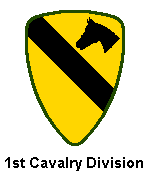



 If none of the data that you have found by surfing the reference unit chapter
titles and indexes measures up to your interests, you may want to deploy the
R&S (Reconnaissance and Surveillance) Scouts to search and identify keywords
or subjects within individual unit pages. Enter the descriptive keyword or
search terms(s) in the input field and "Click" on the Search button to screen the multiple DataBases of
the Cavalry OutPost and the garrisoned occupants - "The 1st Cavalry Division
and its Subordinate Units".
If none of the data that you have found by surfing the reference unit chapter
titles and indexes measures up to your interests, you may want to deploy the
R&S (Reconnaissance and Surveillance) Scouts to search and identify keywords
or subjects within individual unit pages. Enter the descriptive keyword or
search terms(s) in the input field and "Click" on the Search button to screen the multiple DataBases of
the Cavalry OutPost and the garrisoned occupants - "The 1st Cavalry Division
and its Subordinate Units".
 The search action will open the "first-team.us WebSite - R&S Scout Report",
which displays a listing of WebSite Titles and HTML Summaries that contain the
specific search term(s) of interest. To review any that best depicts a match
of your search term(s), "Click" on the WebSite Title to open a New Window.
After the WebSite is fully loaded, use the browser [EDIT/Find] Tool Button to
locate the search term within the page. After reviewing, close the New Window
to return to the listing of WebSites.
The search action will open the "first-team.us WebSite - R&S Scout Report",
which displays a listing of WebSite Titles and HTML Summaries that contain the
specific search term(s) of interest. To review any that best depicts a match
of your search term(s), "Click" on the WebSite Title to open a New Window.
After the WebSite is fully loaded, use the browser [EDIT/Find] Tool Button to
locate the search term within the page. After reviewing, close the New Window
to return to the listing of WebSites.
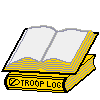



 If this is your first review of the Outpost of the 1st Cavalry Division and
its Subordinate Units, you may want to record your own report on your findings
during your visit, or perhaps you may want to review the log entries of other
visitors.
If this is your first review of the Outpost of the 1st Cavalry Division and
its Subordinate Units, you may want to record your own report on your findings
during your visit, or perhaps you may want to review the log entries of other
visitors.

To report on your findings,
"click" on the "Report-In"
Index Tab of the Troop Log. |
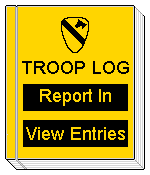
|

To review entries of others,
"Click"on the "View Entries"
Index Tab of the Troop Log. |
|---|

 As you journey through the history of the 1st Cavalry Division and its
assigned elements, you may find it interesting enough to send a message to
your friends and extend them an invitation for the opportunity to review the
rich history of the Division. We have made it easy for you to do. All that is
required is for you to click on the Push Button below, fill in their eMail
addresses and send.
As you journey through the history of the 1st Cavalry Division and its
assigned elements, you may find it interesting enough to send a message to
your friends and extend them an invitation for the opportunity to review the
rich history of the Division. We have made it easy for you to do. All that is
required is for you to click on the Push Button below, fill in their eMail
addresses and send.


|
The TITLE and URL of this WebSite are automatically read, formatted
and entered into your standard eMail form. |
|
|
Note - The eMail Message is processed and transmitted On-Line to the
addressee(s) via your Internet Provider.
Copyright © 2002, Cavalry Outpost Publications ® |




 eMail Your WebSite Comments.
eMail Your WebSite Comments.


 Return to "MyOwnPages"©.
Return to "MyOwnPages"©.

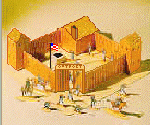 Copyright © 1996, Cavalry Outpost Publications ® and
Trooper Wm. H. Boudreau, "F" Troop, 8th Cavalry Regiment (1946 - 1947). All
rights to this body of work are reserved and are not in the public domain, or
as noted in the bibliography. Reproduction, or transfer by electronic means,
of the History of the 1st Cavalry Division, the subordinate units or any
internal element, is not permitted without prior authorization. Readers are
encouraged to link to any of the pages of this Web site, provided that proper
acknowledgment attributing to the source of the data is made. The information
or content of the material contained herein is subject to change without
notice.
Copyright © 1996, Cavalry Outpost Publications ® and
Trooper Wm. H. Boudreau, "F" Troop, 8th Cavalry Regiment (1946 - 1947). All
rights to this body of work are reserved and are not in the public domain, or
as noted in the bibliography. Reproduction, or transfer by electronic means,
of the History of the 1st Cavalry Division, the subordinate units or any
internal element, is not permitted without prior authorization. Readers are
encouraged to link to any of the pages of this Web site, provided that proper
acknowledgment attributing to the source of the data is made. The information
or content of the material contained herein is subject to change without
notice.
Revised 05 Apr '12 SpellChecked



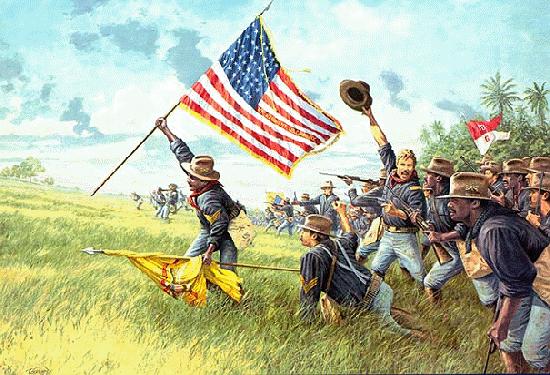


 Introduction
Introduction















 Copyright © 1996, Cavalry Outpost Publications ® and
Trooper Wm. H. Boudreau, "F" Troop, 8th Cavalry Regiment (1946 - 1947). All
rights to this body of work are reserved and are not in the public domain, or
as noted in the bibliography. Reproduction, or transfer by electronic means,
of the History of the 1st Cavalry Division, the subordinate units or any
internal element, is not permitted without prior authorization. Readers are
encouraged to link to any of the pages of this Web site, provided that proper
acknowledgment attributing to the source of the data is made. The information
or content of the material contained herein is subject to change without
notice.
Copyright © 1996, Cavalry Outpost Publications ® and
Trooper Wm. H. Boudreau, "F" Troop, 8th Cavalry Regiment (1946 - 1947). All
rights to this body of work are reserved and are not in the public domain, or
as noted in the bibliography. Reproduction, or transfer by electronic means,
of the History of the 1st Cavalry Division, the subordinate units or any
internal element, is not permitted without prior authorization. Readers are
encouraged to link to any of the pages of this Web site, provided that proper
acknowledgment attributing to the source of the data is made. The information
or content of the material contained herein is subject to change without
notice.